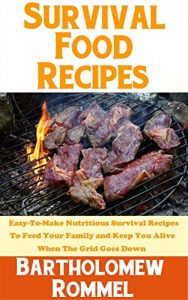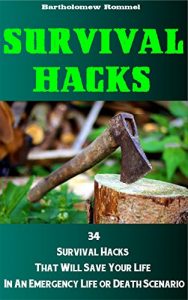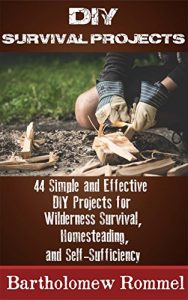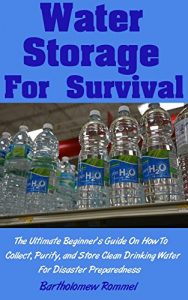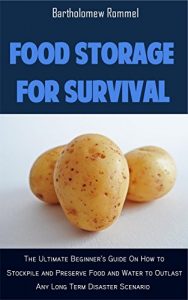A significant amount of the time that you spend in any survival or disaster situation, much more than you probably assume, is going to be preparing and cooking meals for yourself and your family.
In a disaster or any emergency scenario for that matter, you will be forced to make quick decisions and you’ll have a fewer number of options before you. This means you still have to quickly figure out how to cook and put a meal together for your family to keep yourselves fed even if you don’t have the same number or kinds of ingredients that you would usually.
In other words, with some pots and pans, a stove, and a few essential ingredients, it’s still perfectly possible for you to cook a full and nutritious meal for your family. This book is going to prove that to you.
There are three primary ways to get food in a disaster or critical survival scenario: what you have stockpiled, what you cultivate (livestock, gardens, etc.), and what you find (hunting, fishing, foraging, scavenging, etc.).
Every one of the meals that we are going to go through in this book can be made out of ingredients that you can easily get through one or more of these three ways, which is why they will each be a suitable choice for a long term disaster or grid down scenario.
Food has to be one of your top priorities in any survival situation. While you can survive for three days without eating, you will feel a severe physical and mental breakdown of not eating in only a day. You’ll feel drained off energy physically and emotionally, and your brain and body will not function to their full potential, which dramatically lowers your chances of survival.
You cannot allow this to happen to you, your family, or anyone else in your survival group. Food is essential, and you have to do more than simply handing out a protein bar to everyone. You should be able to cook a complete meal to ensure that everyone gets the ingredients and the nutrition they need.
This book will walk you through several different recipes that use ingredients you have stored, cultivated, or can find, and a step-by-step instruction process for how to prepare each meal.
The specific recipes that we will go over include the following:
•Baked Beans
•Bean and Mushroom Soup
•Beans and Rice Mix
•Bean and Rice Patties
•Carrots and Peas Salad
•Chicken and Noodles
•Chicken Soup
•Hardtack
•Homemade Jerky
•Hummus
•Indian Bread
•Macaroni with Cheese (Tomato)
•Peanut Butter Energy Bars
•Pemmican
•Potato Pancakes
•Sausage Gravy
•Trail Biscuits
•Trout
Do not be scared to experiment with these recipes either. Even though we’re going to go through specific ingredients and directions for making each one, you can easily add or subtract ingredients depending on how you see fit.
You can keep this book as a guide for the future, and while you can definitely practice making these recipes for fun in your everyday life now, more importantly you’ll be able to refer back to this book when a true disaster situation strikes.
In a disaster or any emergency scenario for that matter, you will be forced to make quick decisions and you’ll have a fewer number of options before you. This means you still have to quickly figure out how to cook and put a meal together for your family to keep yourselves fed even if you don’t have the same number or kinds of ingredients that you would usually.
In other words, with some pots and pans, a stove, and a few essential ingredients, it’s still perfectly possible for you to cook a full and nutritious meal for your family. This book is going to prove that to you.
There are three primary ways to get food in a disaster or critical survival scenario: what you have stockpiled, what you cultivate (livestock, gardens, etc.), and what you find (hunting, fishing, foraging, scavenging, etc.).
Every one of the meals that we are going to go through in this book can be made out of ingredients that you can easily get through one or more of these three ways, which is why they will each be a suitable choice for a long term disaster or grid down scenario.
Food has to be one of your top priorities in any survival situation. While you can survive for three days without eating, you will feel a severe physical and mental breakdown of not eating in only a day. You’ll feel drained off energy physically and emotionally, and your brain and body will not function to their full potential, which dramatically lowers your chances of survival.
You cannot allow this to happen to you, your family, or anyone else in your survival group. Food is essential, and you have to do more than simply handing out a protein bar to everyone. You should be able to cook a complete meal to ensure that everyone gets the ingredients and the nutrition they need.
This book will walk you through several different recipes that use ingredients you have stored, cultivated, or can find, and a step-by-step instruction process for how to prepare each meal.
The specific recipes that we will go over include the following:
•Baked Beans
•Bean and Mushroom Soup
•Beans and Rice Mix
•Bean and Rice Patties
•Carrots and Peas Salad
•Chicken and Noodles
•Chicken Soup
•Hardtack
•Homemade Jerky
•Hummus
•Indian Bread
•Macaroni with Cheese (Tomato)
•Peanut Butter Energy Bars
•Pemmican
•Potato Pancakes
•Sausage Gravy
•Trail Biscuits
•Trout
Do not be scared to experiment with these recipes either. Even though we’re going to go through specific ingredients and directions for making each one, you can easily add or subtract ingredients depending on how you see fit.
You can keep this book as a guide for the future, and while you can definitely practice making these recipes for fun in your everyday life now, more importantly you’ll be able to refer back to this book when a true disaster situation strikes.
